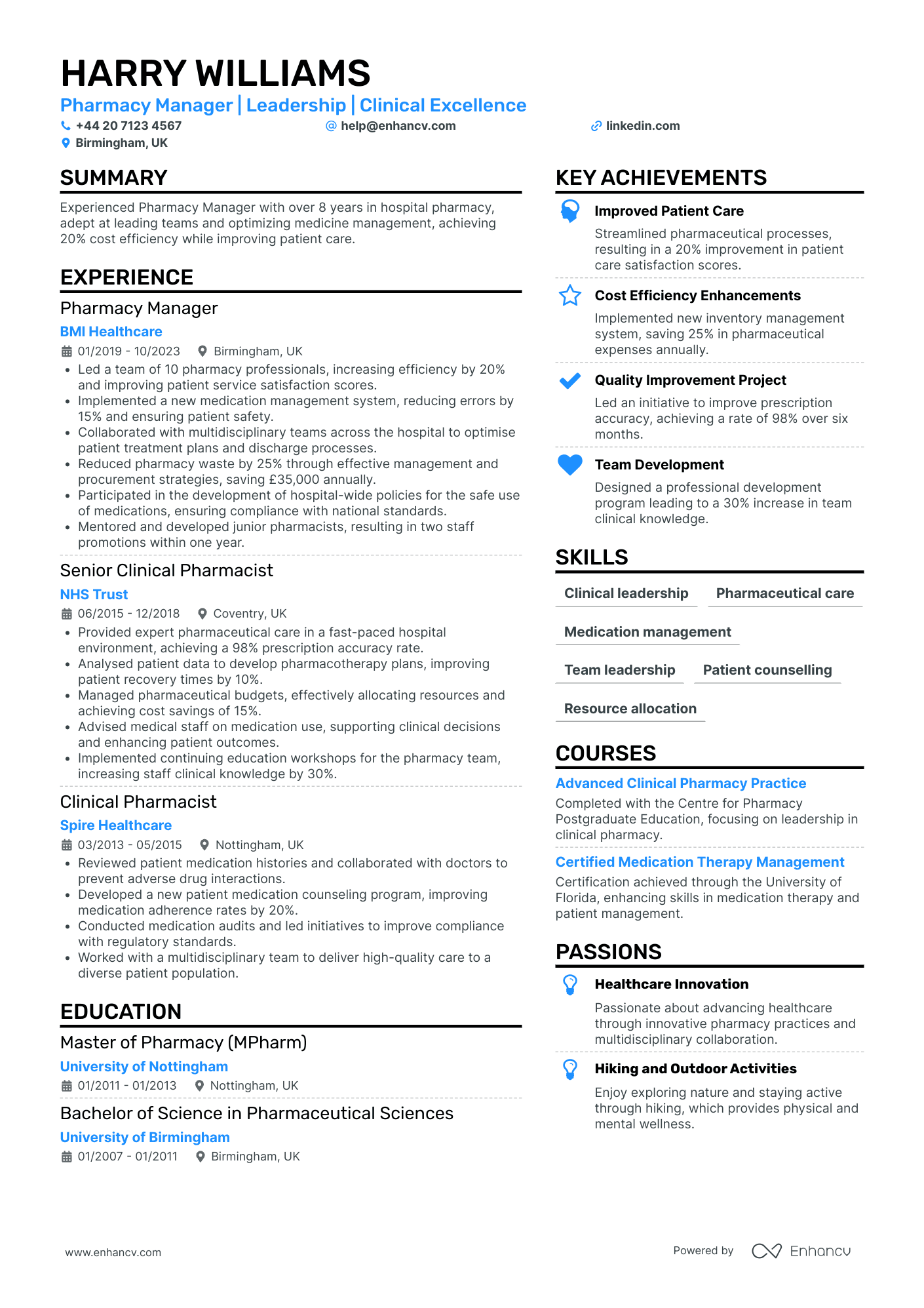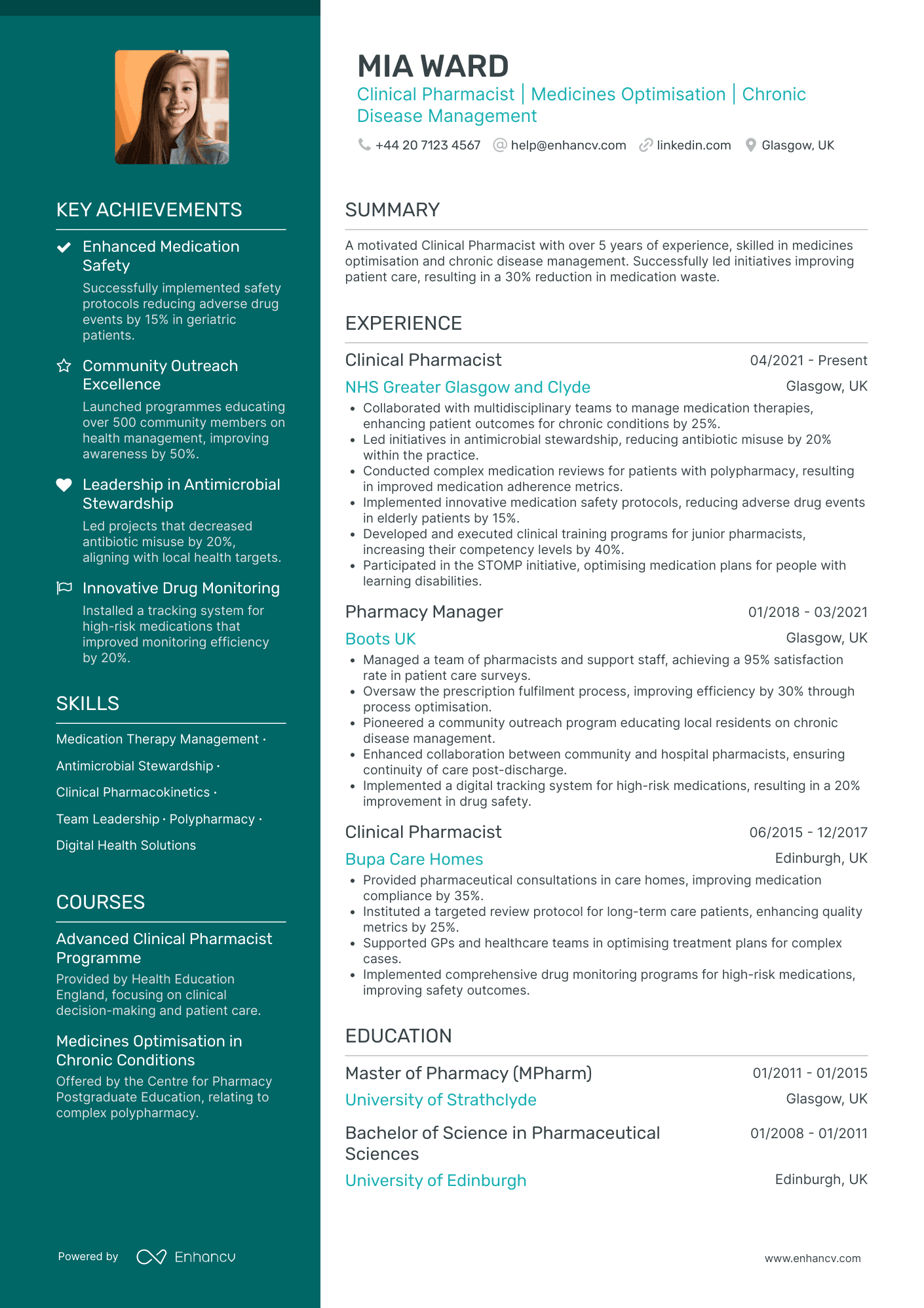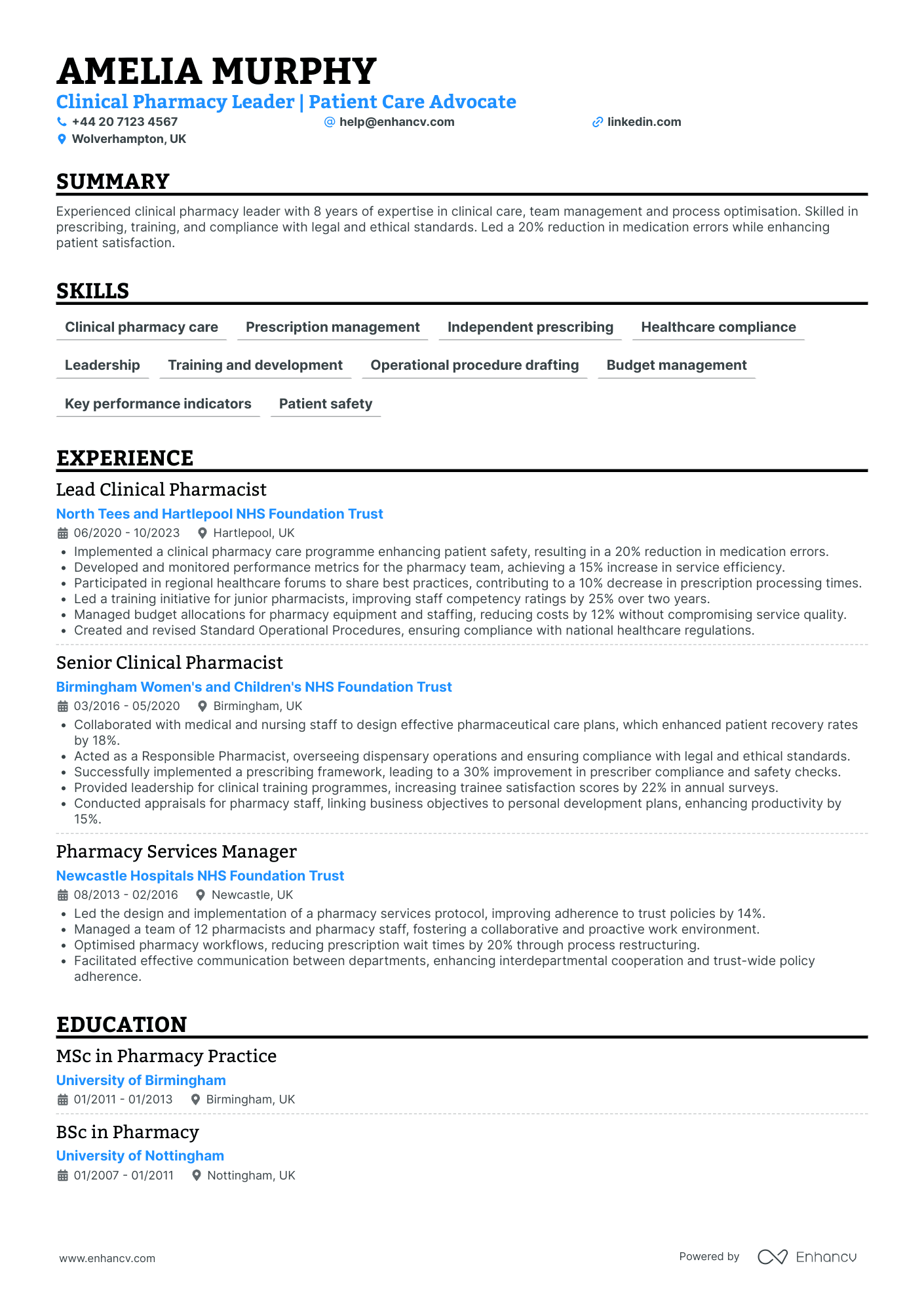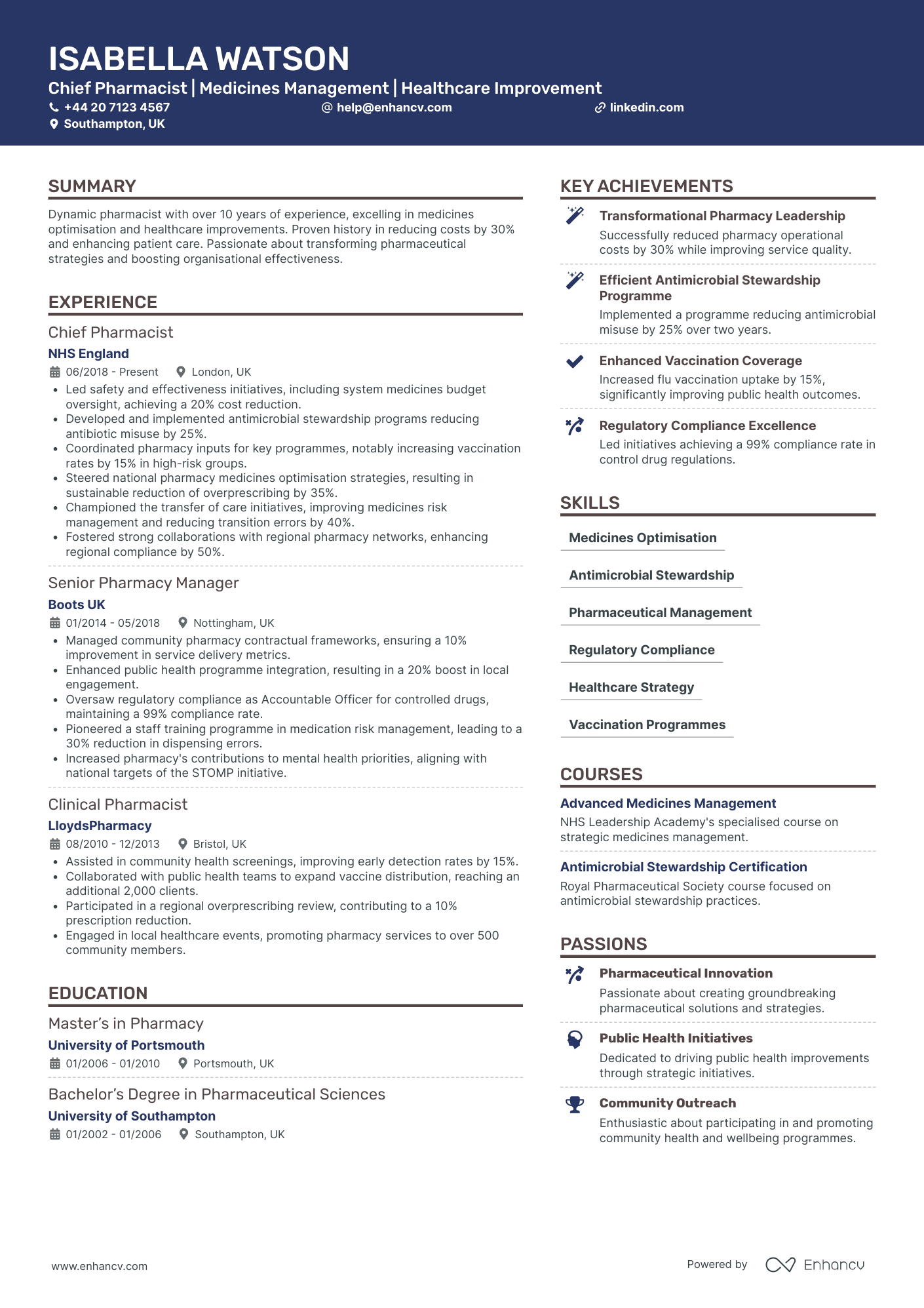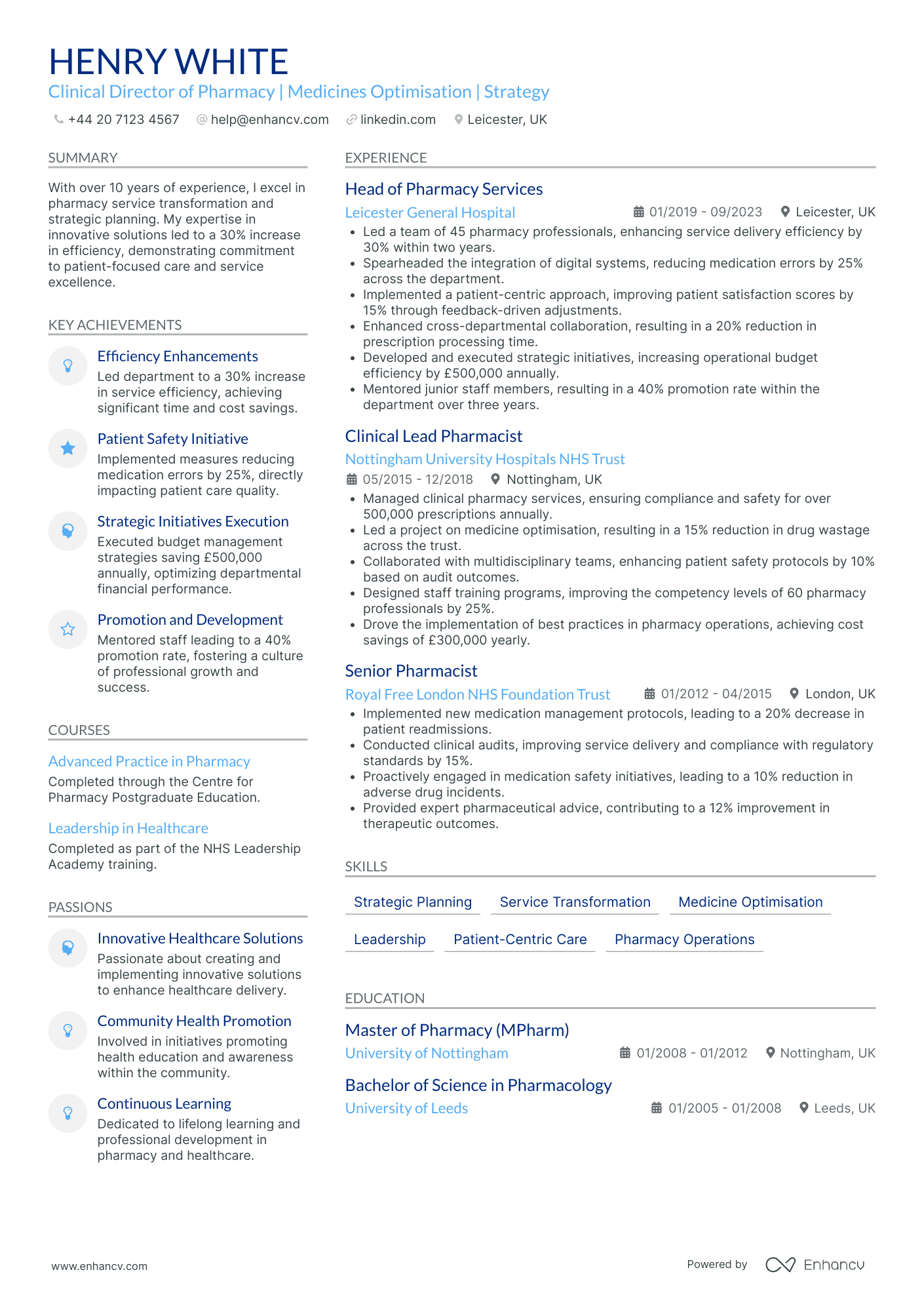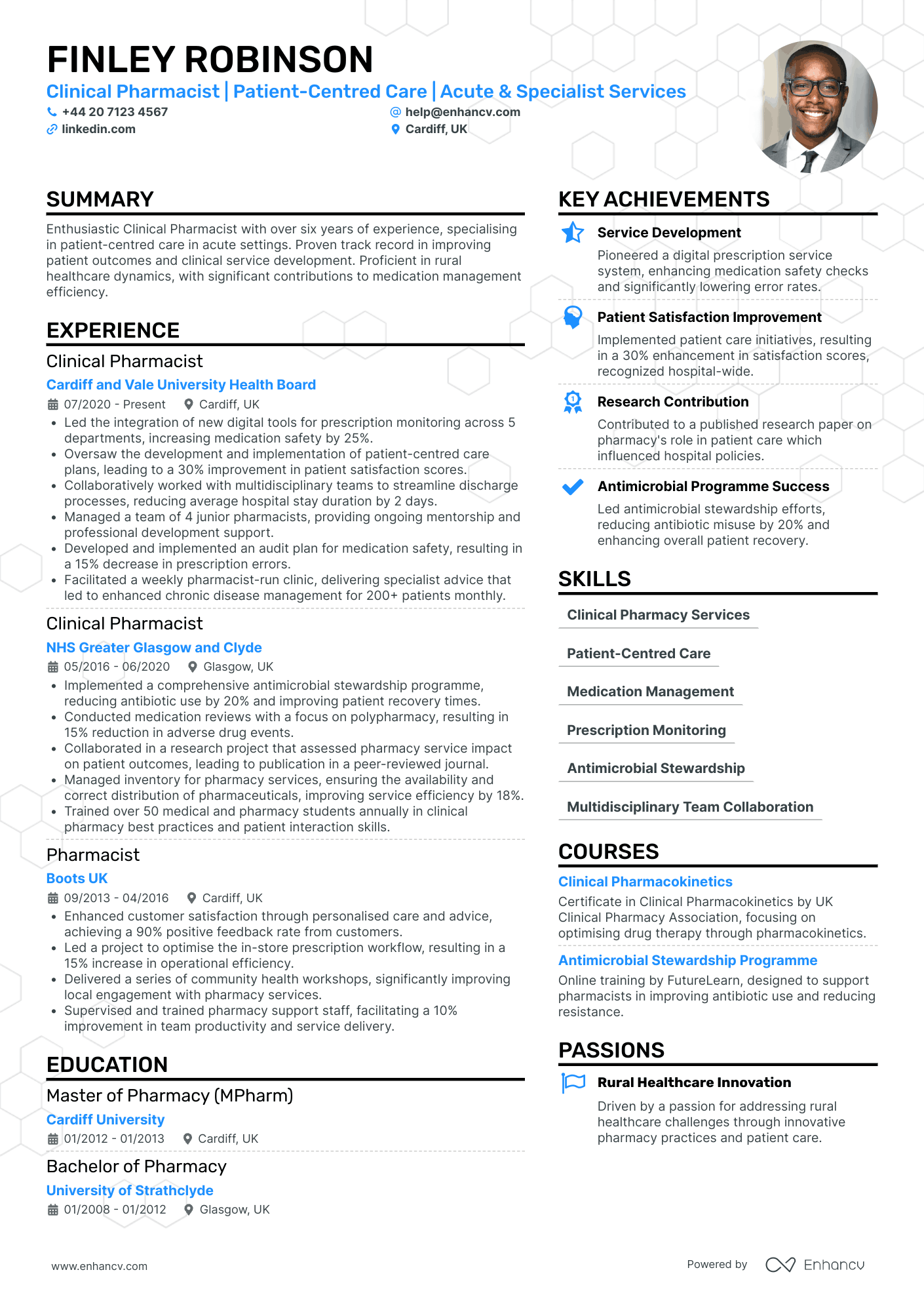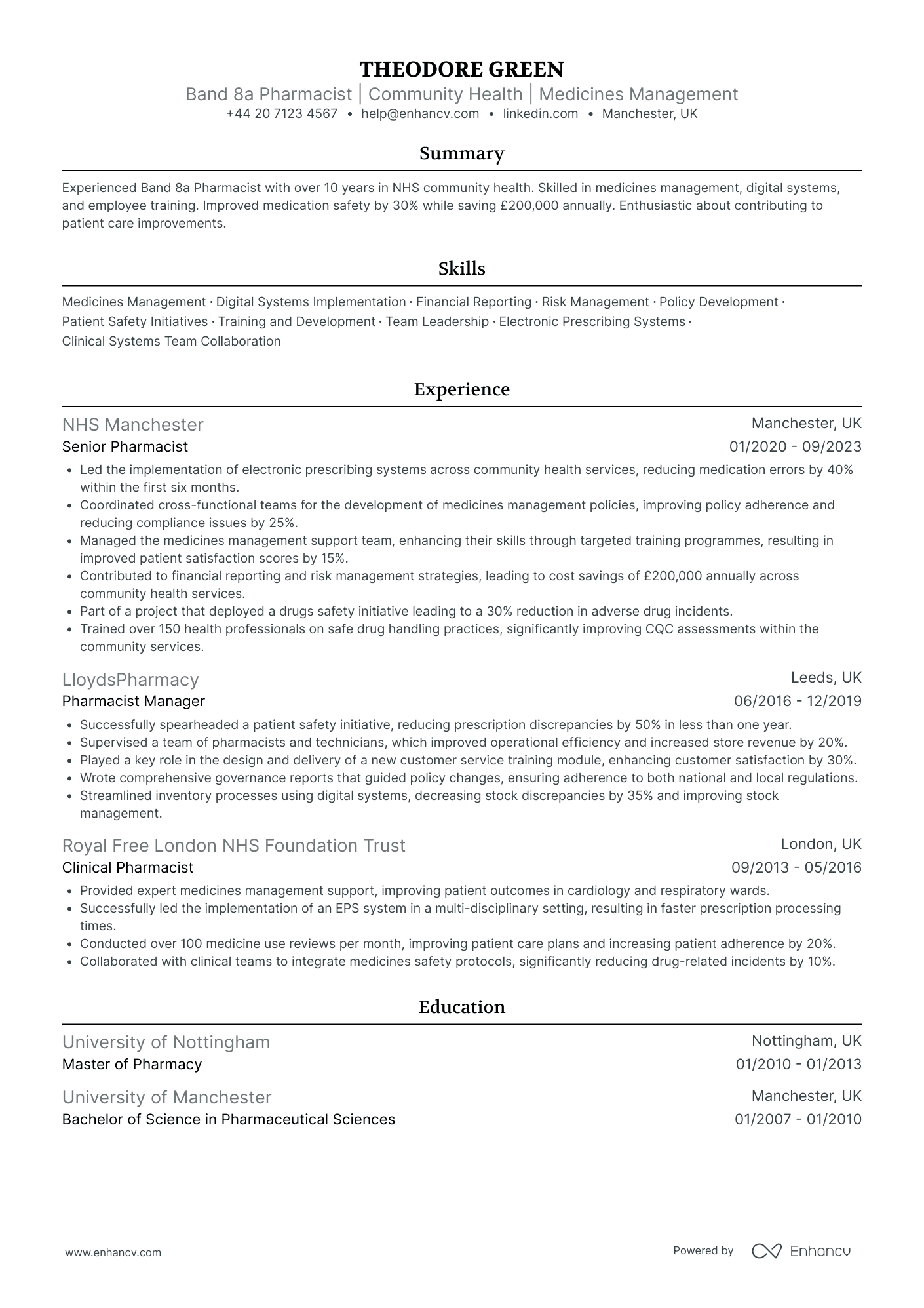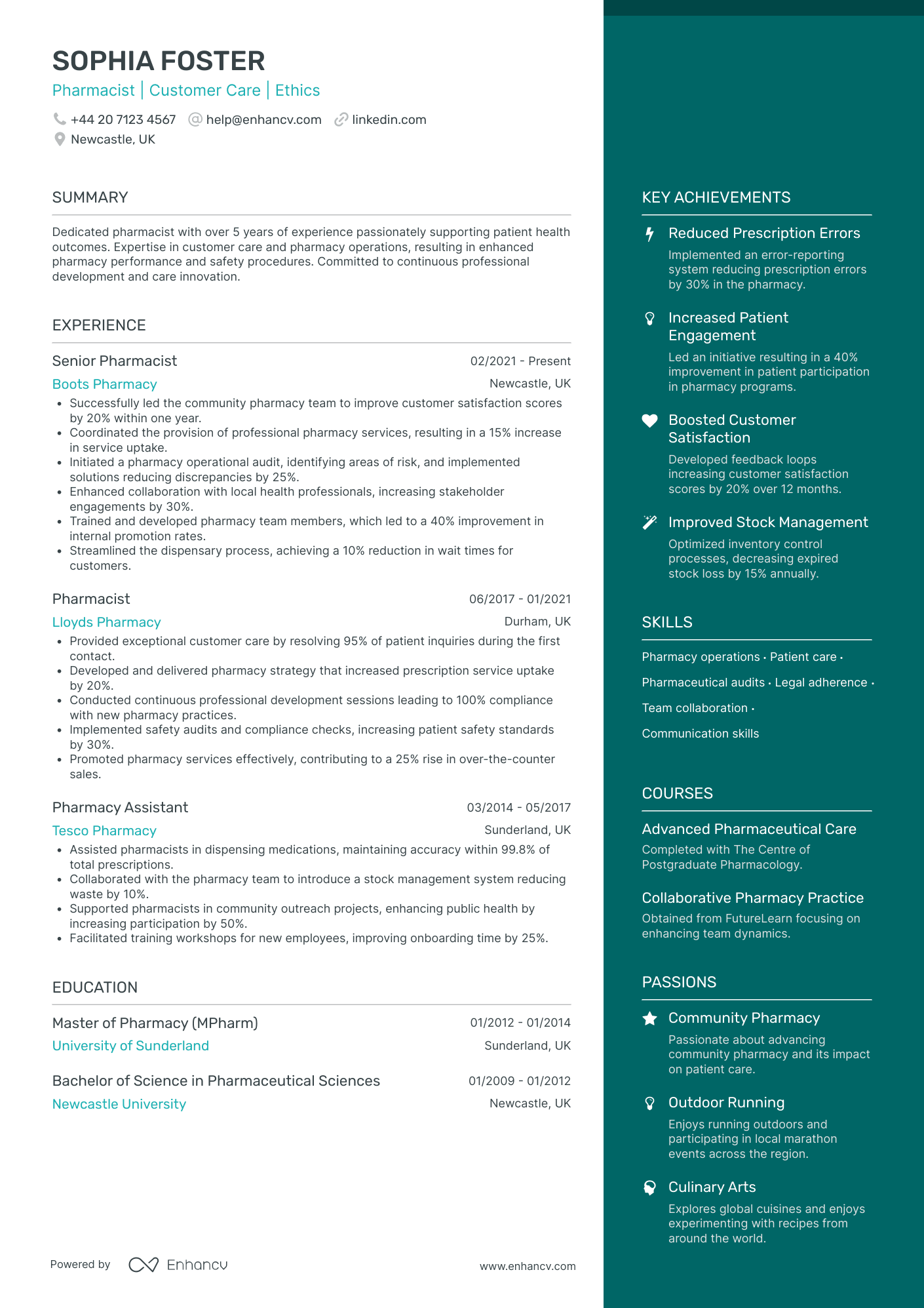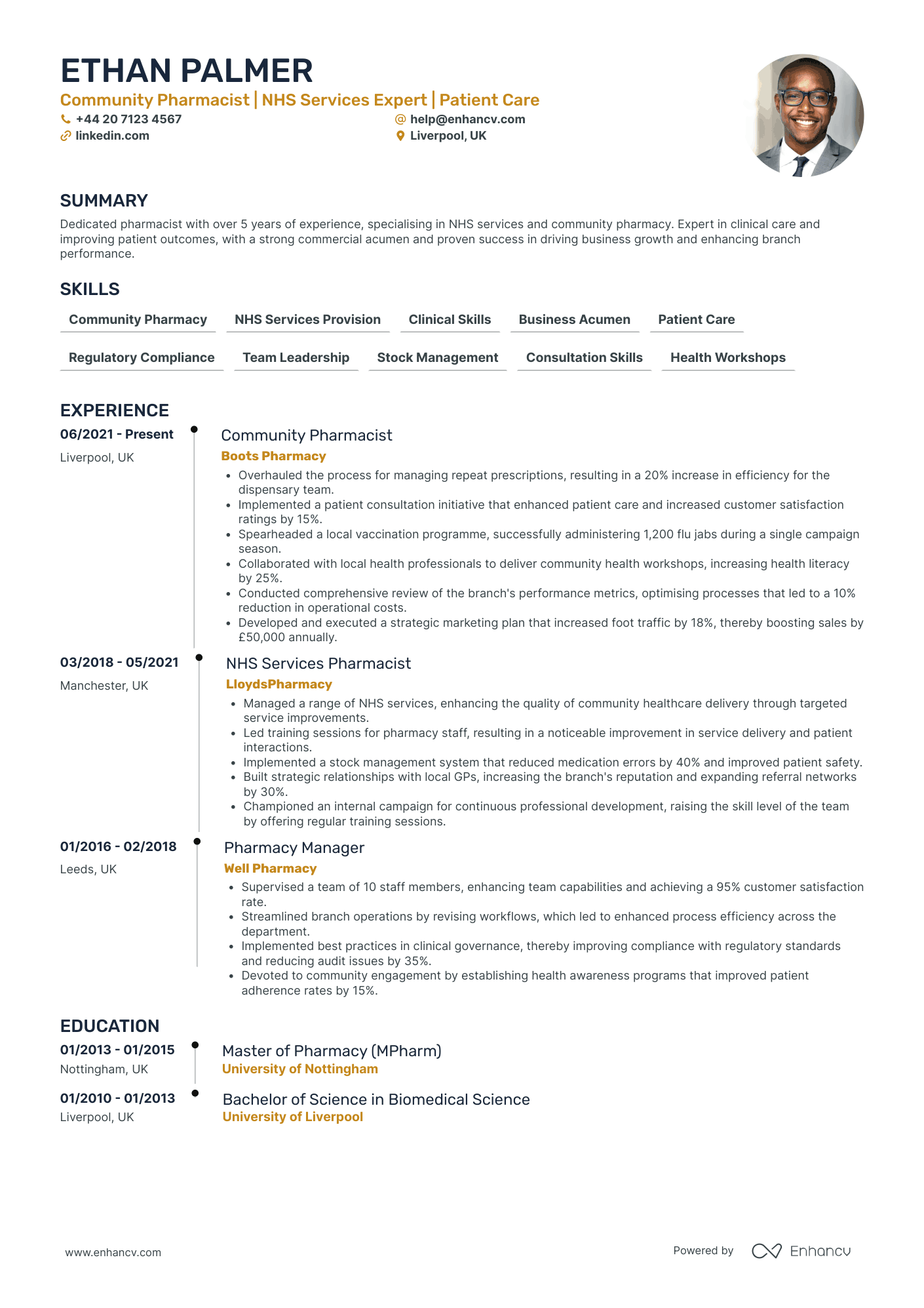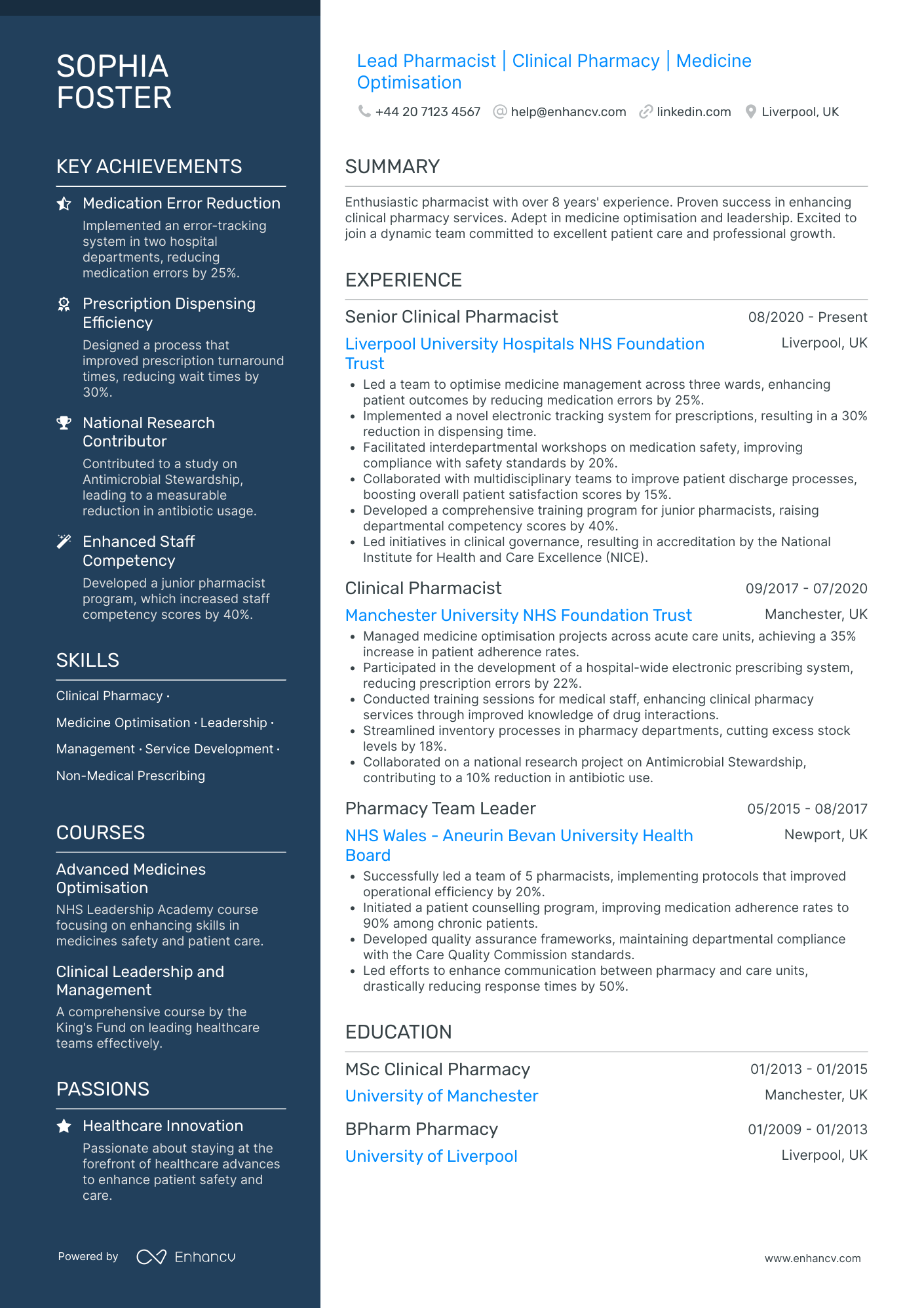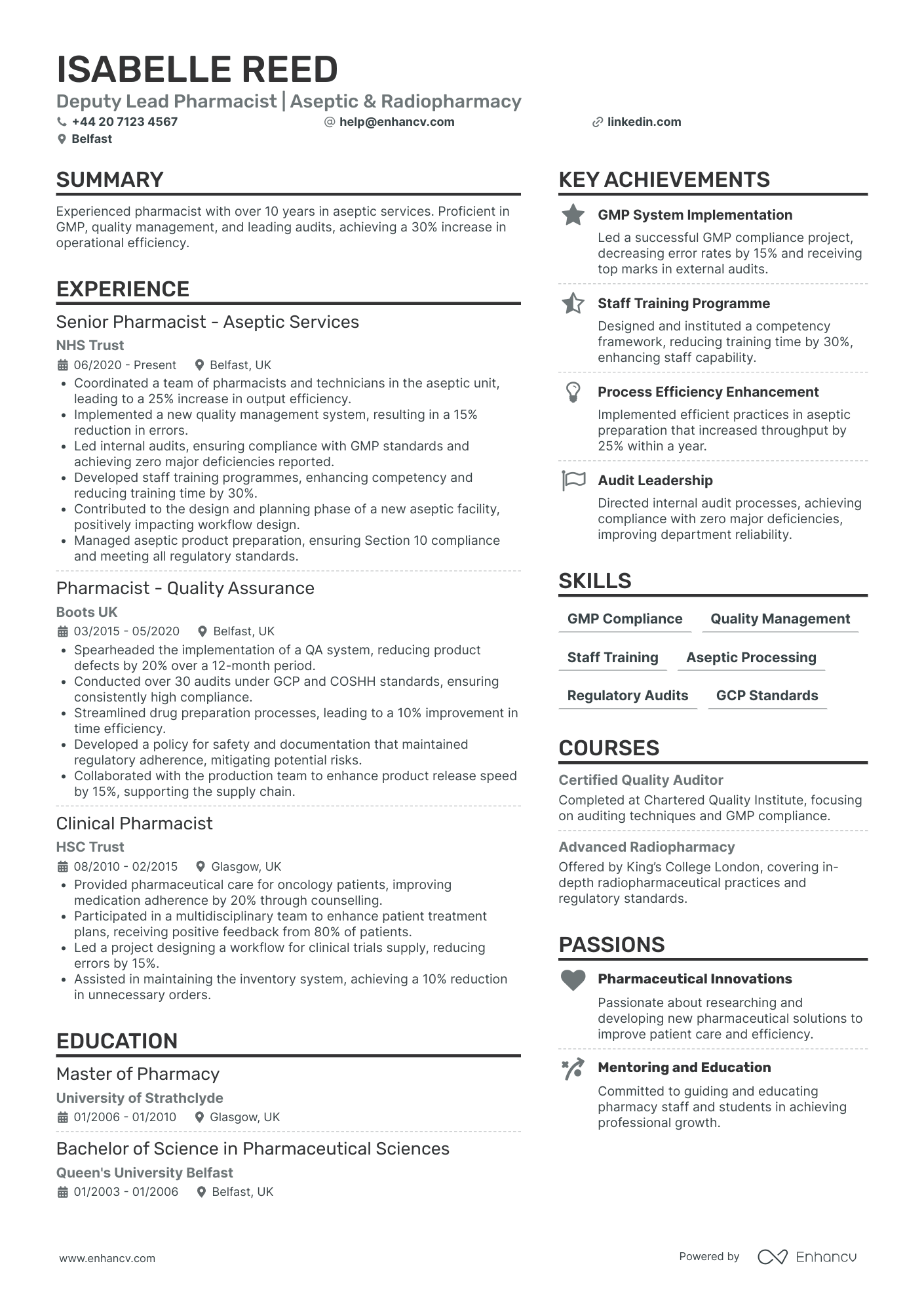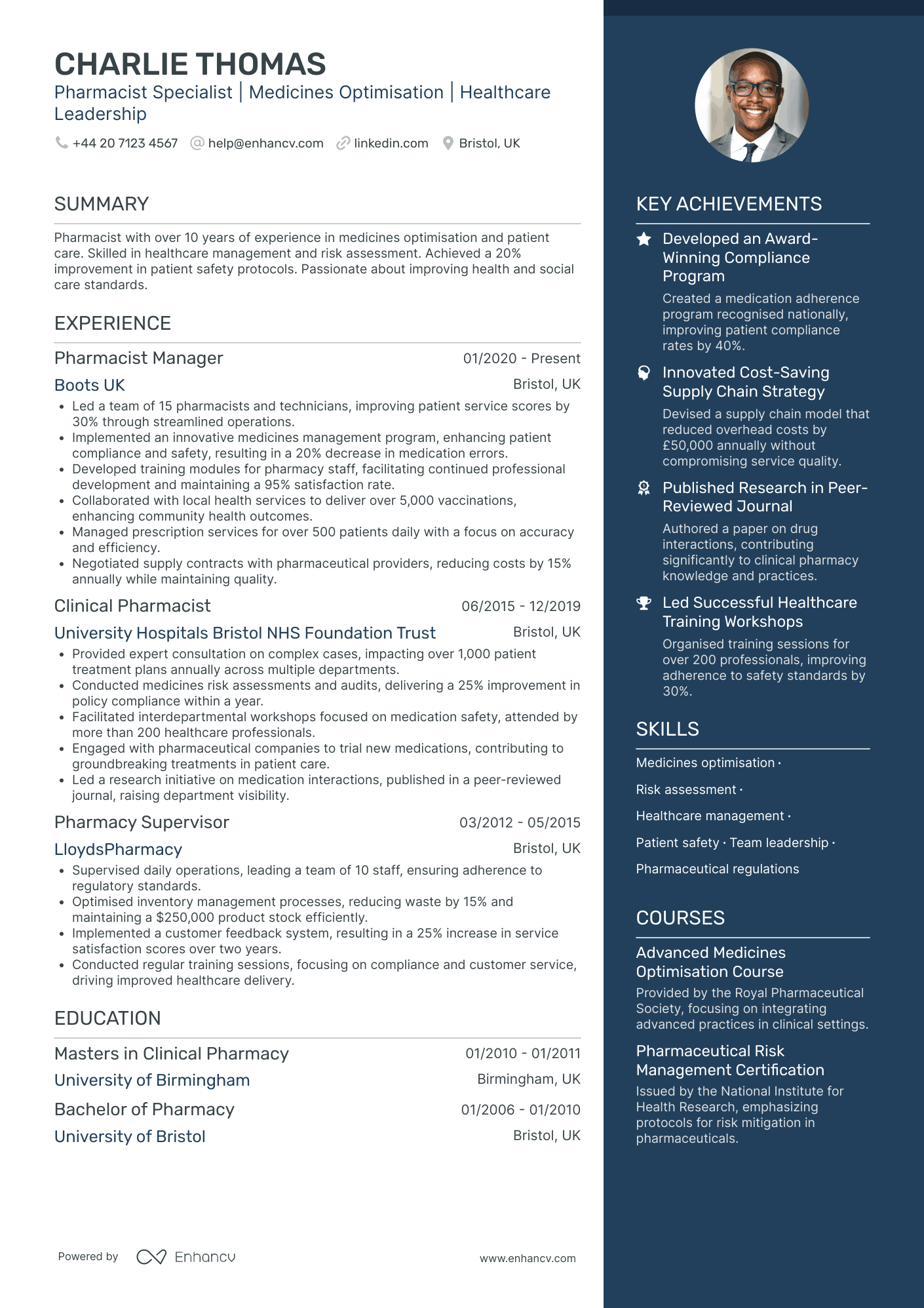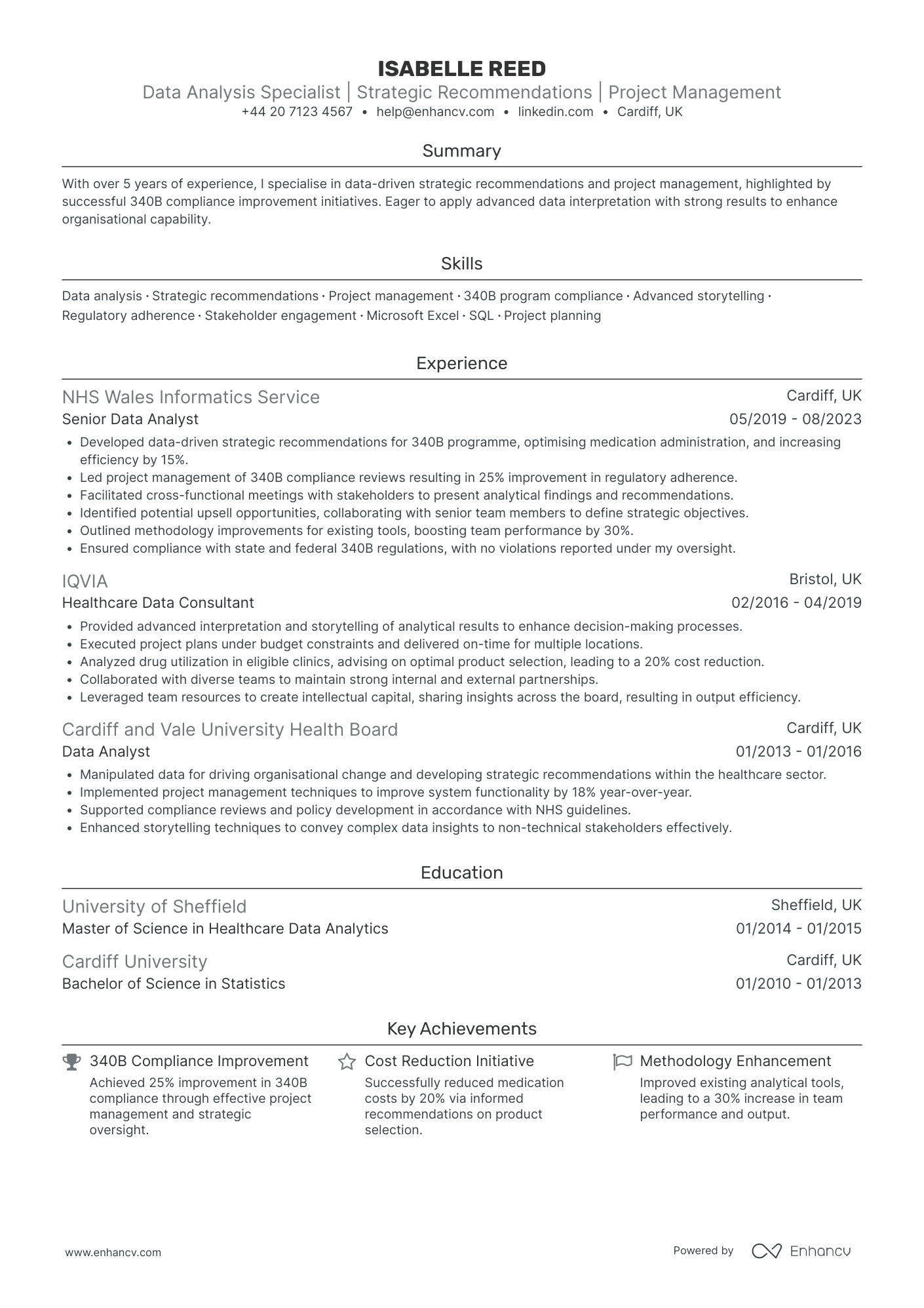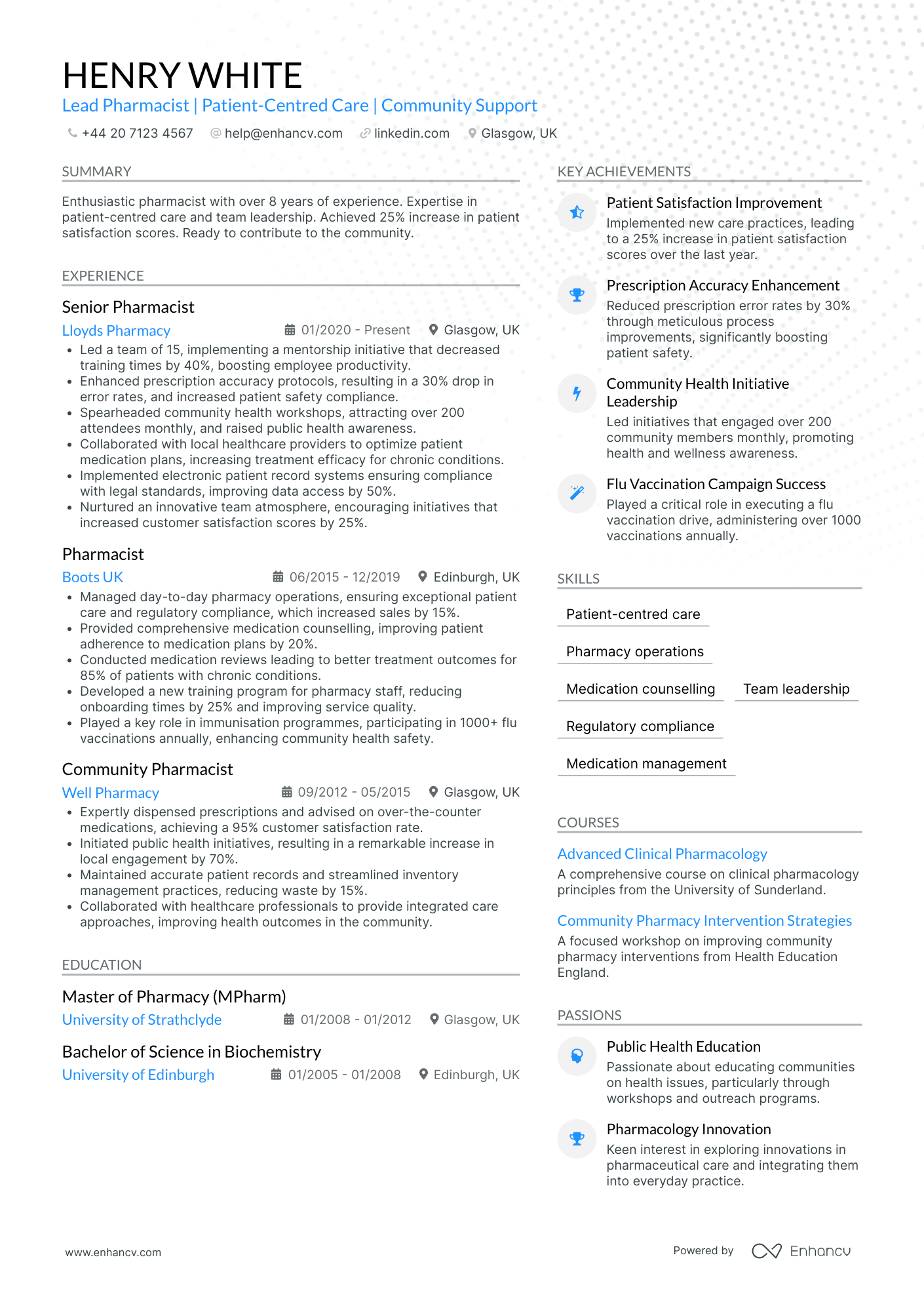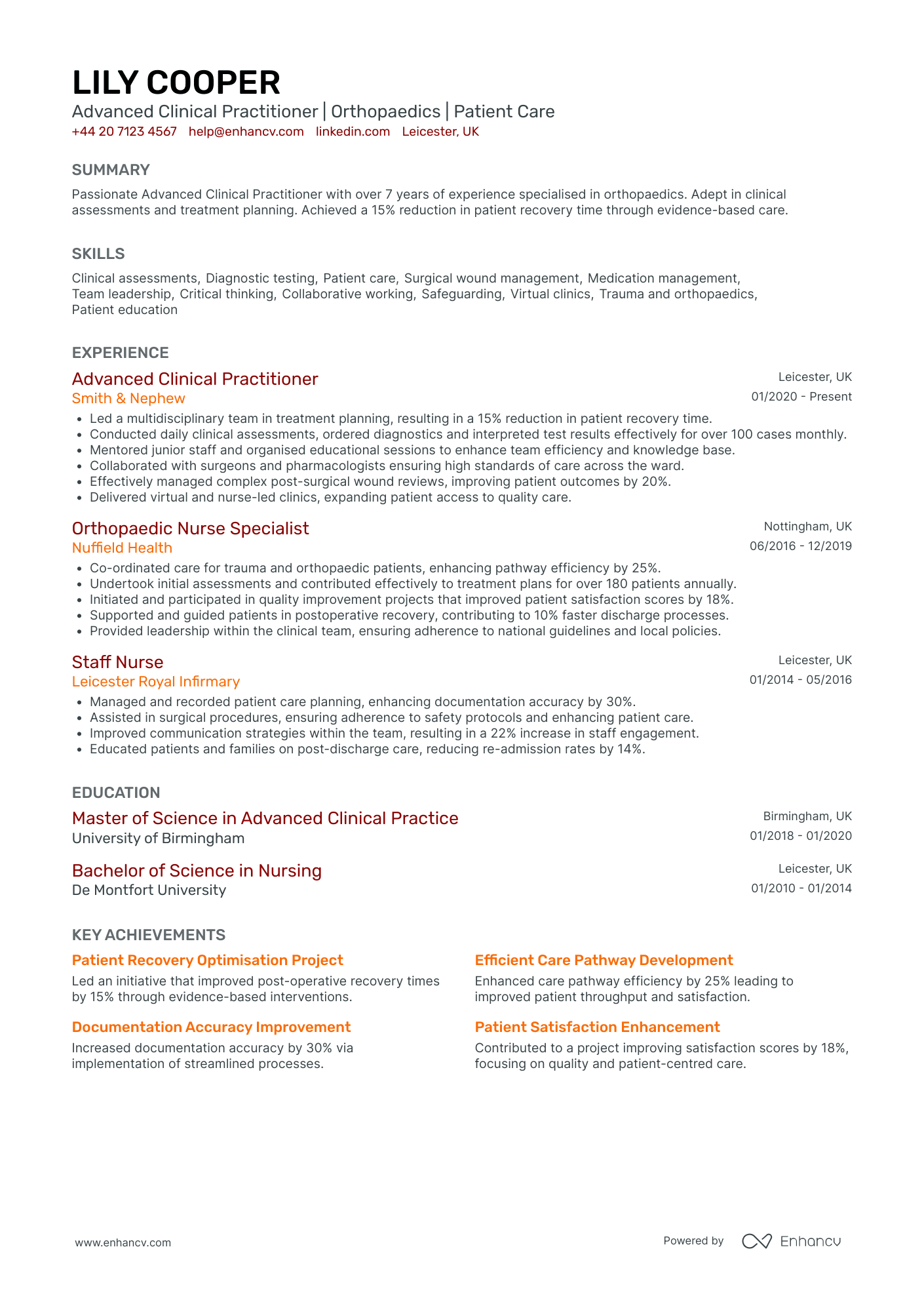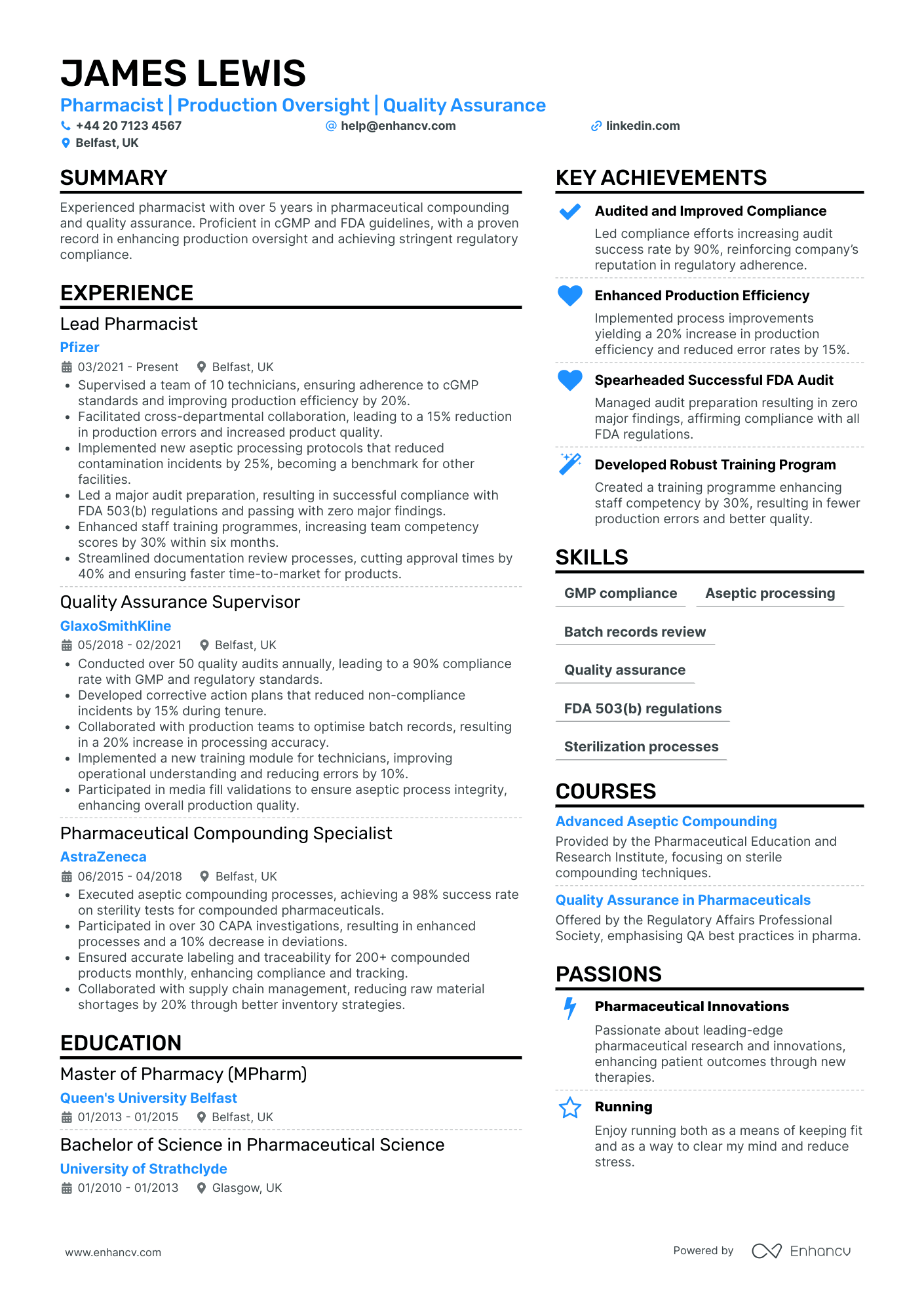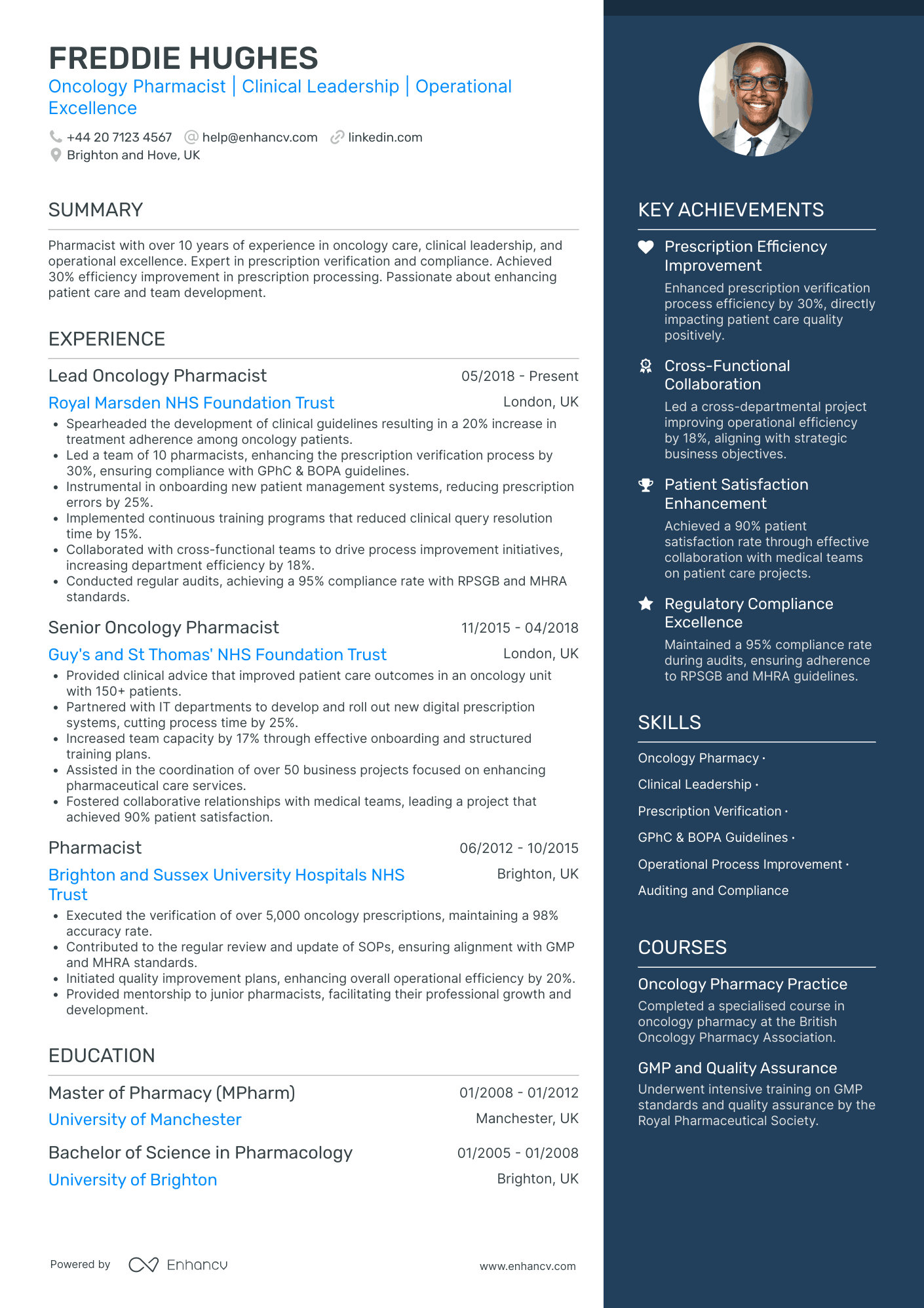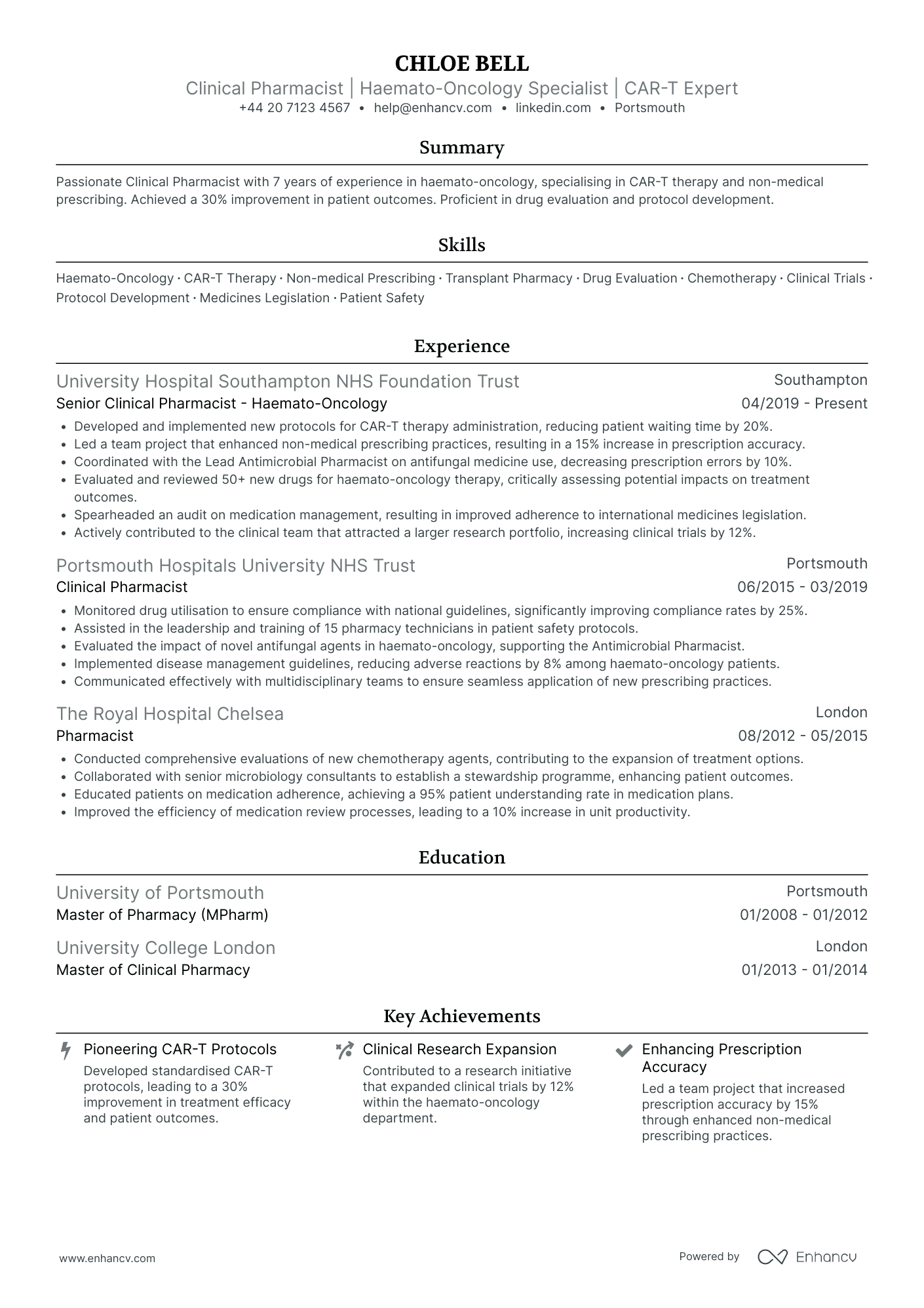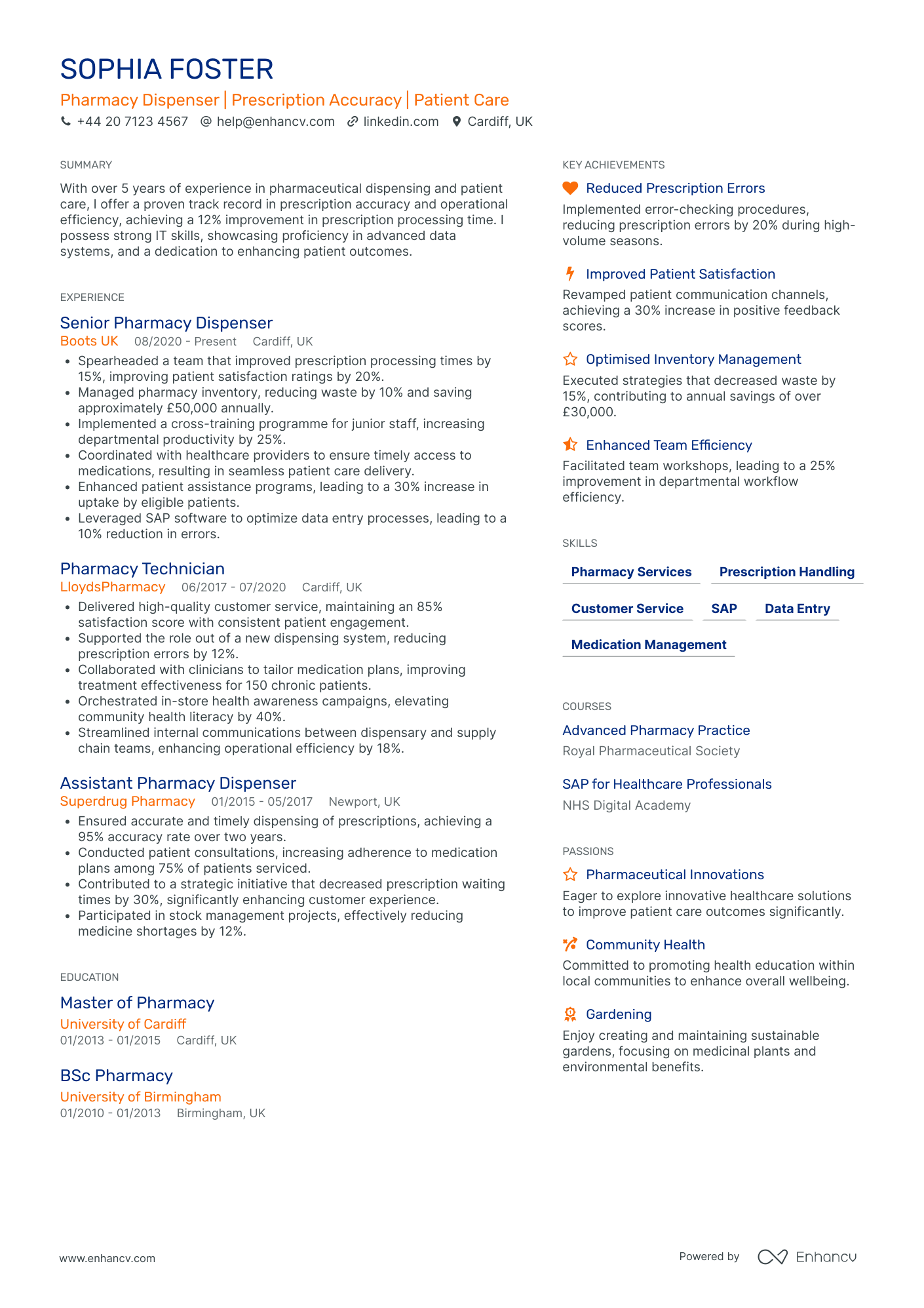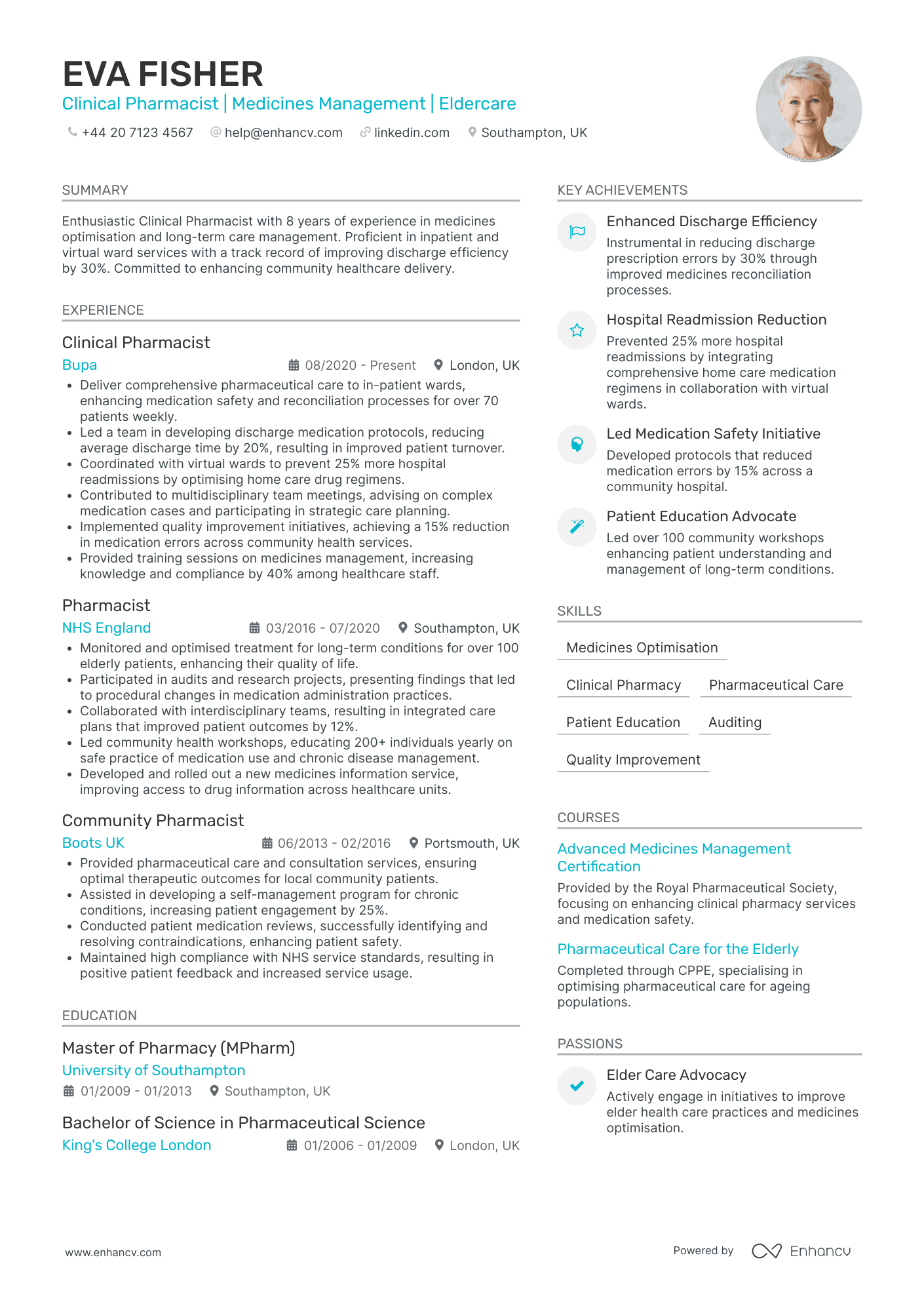Crafting a CV that effectively showcases your clinical expertise and interpersonal skills is a significant challenge faced by pharmacists. By utilizing our comprehensive guide, you will learn how to create a compelling CV that highlights your unique qualifications and sets you apart in a competitive job market.
- Applying the simplest CV design, so that recruiters can easily understand your expertise, skills, and professional background;
- Ensuring you stand out with your header, summary or objective statement, and a designated skills section;
- Creating your CV experience section - no matter how much expertise you have;
- Using real life professional CV examples to enhance the structure and outline of your profile.
If you still have no muse to write your professional CV, find some more industry-leading examples.
CV examples for pharmacist
By Experience
Pharmacy Manager
- Structured Career Advancement - The CV effectively showcases a clear career progression, moving from a Clinical Pharmacist position to a Pharmacy Manager role. This growth demonstrates increasing responsibilities and leadership capabilities, underscoring the candidate’s ability to excel in management within the pharmaceutical industry.
- Impact-Driven Achievements - The CV highlights significant accomplishments that directly impact business results, such as achieving 20% cost efficiency in medicine management and saving £35,000 annually through waste reduction strategies. These achievements illustrate the candidate's capability to implement effective changes and drive financial success.
- Integration of Industry-Specific Expertise - The document effectively threads industry-specific methodologies and tools, such as cost-efficient medicine management systems and compliance with national standards. This demonstrates an in-depth technical understanding and capability to enhance patient care through innovative pharmaceutical practices.
Senior Pharmacist
- Structured with precision and clarity - The CV presents information in a concise and organized manner, making it easy for recruiters to quickly identify key attributes. Each section is clear and to the point, with well-defined roles and achievements, enhancing readability and effectiveness.
- Demonstrates continuous professional growth - The career trajectory of Mia Ward shows a progressive advancement from a Pharmacy Manager to a Clinical Pharmacist, indicating a focus on specialization in medicines optimization. This progression highlights her commitment to developing expertise and taking on increased responsibilities.
- Implementation of industry-specific methodologies - The CV emphasizes Mia’s expertise in antimicrobial stewardship and chronic disease management, which are crucial in the clinical pharmacy field. Her work in developing medication safety protocols and implementing digital health solutions demonstrates her technical depth and industry knowledge.
Lead Pharmacist
- Clear Career Advancement - Amelia Murphy's CV highlights a progressive career path, from Pharmacy Services Manager to Lead Clinical Pharmacist. This trajectory showcases not only her growth within the pharmacy sector but also her increasing responsibilities in leadership and operational management. Her advancements demonstrate her capability to take on complex challenges and deliver impactful results, which is crucial for her role as a Clinical Pharmacy Leader.
- Emphasis on Achievements and Impact - The document places a strong focus on Amelia's results-oriented approach, detailing achievements such as reducing medication errors by 20% and improving prescriber compliance by 30%. These accomplishments not only underscore her effectiveness but also illustrate her direct contribution to enhancing patient safety and operational efficiency within healthcare settings.
- Comprehensive Skill Set and Educational Background - Amelia's CV is well-structured to highlight both her practical skills and educational qualifications. With degrees in Pharmacy from reputable institutions and certifications in advanced clinical practices, her background is well-suited to lead in a clinical pharmacy setting. The inclusion of skills like healthcare compliance and leadership align seamlessly with her professional aspirations.
Chief Pharmacist
- Structured and Comprehensive Layout - The CV is well-structured with clearly defined sections, including summary, experience, education, skills, and achievements, providing a comprehensive view of the candidate's career. Each section is succinct and strategically placed to highlight the candidate's strengths, making it easy to navigate and understand.
- Substantial Career Progression - Isabella Watson's career trajectory showcases a steady progression from a Clinical Pharmacist to her current role as Chief Pharmacist. This reflects significant growth and adaptability, as she has successfully transitioned from frontline pharmacy roles to overarching leadership positions within the healthcare sector.
- Impactful Achievements with Sector Relevance - The CV details achievements that are not only quantified but also highly relevant to the industry, such as leading national pharmacy optimisation strategies and reducing antibiotic misuse. These accomplishments underscore the candidate's ability to implement effective, large-scale initiatives that contribute to healthcare improvement and cost management.
Director of Pharmacy
- Structured Career Progression - Henry White’s CV showcases a clear trajectory of growth within the pharmacy sector. Starting as a Senior Pharmacist at Royal Free London, he progressed to Clinical Lead Pharmacist at Nottingham University Hospitals NHS Trust, culminating in his role as Head of Pharmacy Services at Leicester General Hospital, signaling steady professional development and increasing responsibility.
- Impactful Achievements with Business Relevance - The achievements outlined in the CV are not only quantitative but also illustrate the tangible impacts on the organization. For example, leading initiatives that improved service delivery efficiency by 30% and reduced medication errors by 25% speak to both operational excellence and enhanced patient care quality, which are critical in a clinical setting.
- Emphasis on Leadership and Mentorship - The CV highlights Henry’s strong leadership skills, particularly his ability to lead large teams and mentor junior staff. His role in increasing the department’s efficiency and fostering junior staff growth through a 40% promotion rate demonstrates a commitment to developing talent and building a culture of professional advancement.
By Role
Clinical Pharmacist
- Structured Career Development and Growth - Finley Robinson's CV illustrates a clear upward trajectory within the field of pharmacy, from an initial role as a Pharmacist at Boots UK to more advanced positions in clinical settings, demonstrating progression and increasing responsibilities. This growth is particularly evident in his transition to leading roles at NHS Greater Glasgow and Clyde and later at Cardiff and Vale University Health Board where he managed significant projects and teams.
- Strong Leadership and Mentorship Capabilities - The CV highlights Robinson’s aptitude for leadership and mentorship, exemplified by his management of a team of junior pharmacists and training of over 50 medical and pharmacy students annually. These experiences reflect his ability to foster professional development in others and his commitment to nurturing talent within the healthcare environment.
- Impactful Contributions to Patient Care and Safety - The document underlines substantial achievements such as a 30% improvement in patient satisfaction scores and a 15% reduction in prescription errors through strategic initiatives. These figures go beyond numerical accomplishments to reveal a strong focus on enhancing patient care and safety, reflecting Robinson's dedication to making a tangible impact in his field.
Community Pharmacist
- Clarity and Structure - The CV is well-organized with clearly defined sections such as experience, education, skills, and achievements. Each section is managed with bullet points that succinctly outline roles and contributions, which makes it easy to navigate and absorb essential information quickly.
- Career Growth and Industry Consistency - Theodore Green’s career trajectory reveals progressive growth in responsibility, evident from his transition from a Clinical Pharmacist to a Senior Pharmacist and leader in medicine management. Despite changes in job titles and locations, he remains within the pharmaceutical sector, showcasing a stable career path and commitment to his field.
- Achievements and Impact - The CV highlights significant achievements, such as reducing medication errors by 40% and attaining £200,000 in cost savings annually. These metrics exemplify Theodore's capability to deliver business-relevant results by integrating innovative practices in medicines management and safety initiatives.
Hospital Pharmacist
- Clear Structure and Conciseness - The CV is well-organized and concise, making it easy to navigate through the key sections such as experience, education, skills, and achievements. The use of bullet points for each experience entry ensures that the information is presented clearly and effectively highlights significant accomplishments.
- Consistent Career Growth - Sophia's career path demonstrates a steady progression from a Pharmacy Assistant to a Senior Pharmacist. This trajectory reflects her dedication to professional development and her ability to handle increasing levels of responsibility, underlining her capability to lead and perform in various pharmacy roles.
- Emphasis on Achievements and Impact - The CV emphasizes tangible achievements and their business relevance. Sophia's contributions are backed by quantifiable results, such as improving customer satisfaction scores, reducing wait times, and optimizing inventory processes. These details not only illustrate her effectiveness but also highlight her impact on pharmacy performance and patient care.
Industrial Pharmacist
- Strategic Business Impact - Ethan Palmer's experience showcases a clear impact on business growth and efficiency, evident in initiatives like optimizing prescription processes and increasing foot traffic, resulting in substantial sales boosts. These actions not only improved operational efficiency but also contributed significantly to the pharmacy's bottom line.
- Robust Career Progression - The CV details a strong career trajectory from Pharmacy Manager to Community Pharmacist and NHS Services Pharmacist. It highlights upward mobility and expanding responsibilities, demonstrating Ethan's commitment to professional growth and his ability to adapt and excel in different environments within the pharmacy industry.
- Focus on Community Engagement - Unique elements such as community health workshops and local vaccination initiatives are standout features, showcasing Ethan's dedication to improving public health. These efforts underline his expertise in using pharmacy services to enhance community health literacy and improve patient outcomes beyond standard pharmacy operations.
Veterinary Pharmacist
- Effective Content Presentation - The CV of Sophia Foster is structured in a manner that is both clear and concise, ensuring that each section is systematically organized. This allows the reader to easily navigate through her professional narrative, highlighting key information such as experience, education, and achievements that are relevant to her role as a Lead Pharmacist.
- Impressive Career Trajectory - Sophia's career exhibits consistent growth and advancement within the healthcare sector. Progressing from a Pharmacy Team Leader to a Senior Clinical Pharmacist, and ultimately a Lead Pharmacist, her CV demonstrates a trajectory marked by increased responsibilities and leadership roles, reflecting her dedication and expertise in the field.
- Strategic Achievements with Impact - The CV effectively communicates Sophia's influence on clinical pharmacy through quantifiable achievements. Her contributions, such as reducing medication errors by 25% and increasing patient adherence rates by 35%, not only demonstrate her technical skills but also underline the real-world impact these achievements have on patient safety and operational efficiency within healthcare settings.
Nuclear Pharmacist
- Effective Content Presentation - The CV is well-structured and easy to navigate, offering a clear overview of Isabelle's experience and qualifications. It concisely presents her career history, achievements, and skills, enabling readers to quickly grasp her expertise and professional growth.
- Strong Career Trajectory - Isabelle's advancement from a Clinical Pharmacist to a Deputy Lead Pharmacist illustrates a robust career trajectory marked by increased responsibilities and leadership roles, reflecting her dedication and professional development within the pharmaceutical industry.
- Technical Competency and Industry-Specific Skills - The CV highlights Isabelle's proficiency in industry-specific tools and methodologies, such as GMP compliance and aseptic processing, coupled with her hands-on experience in radiopharmacy. This technical depth underscores her capability to manage and improve pharmaceutical operations effectively.
Home Health Pharmacist
- Structured and Comprehensive Presentation - Charlie's CV stands out due to its clear, well-organized structure, beginning with a succinct yet informative summary that captures his extensive experience and core competencies in healthcare. Each section is logically sequenced, providing concise yet detailed insights into his career achievements, skills, and personal interests, which enhances readability and enhances the overall impact.
- Demonstrates Proactive Leadership and Industry Impact - The CV highlights Charlie's swift progression and leadership in the pharmaceutical industry, showcasing his transition from Pharmacy Supervisor to Pharmacist Manager. Significant achievements, such as achieving a 20% reduction in medication errors through innovative programs, underscore his proactive approach and pronounced impact on patient safety and healthcare optimization.
- Focus on Achievements with Real-World Impact - Charlie's CV provides clear examples of significant business relevance in his achievements. His work in leading a research initiative that resulted in published findings demonstrates not only his expertise but also his contribution to pharmaceutical knowledge and best practices, further emphasizing his role in advancing industry standards.
Consultant Pharmacist
- Effective Structure and Clarity - The CV uses an organized structure with clearly defined sections, making information easily digestible. The use of bullet points in the experience section aids in presenting key responsibilities and achievements concisely, allowing the reader to quickly understand Isabelle Reed’s contributions and accomplishments.
- Consistent Career Growth in Healthcare - Isabelle’s career trajectory demonstrates clear growth within the healthcare analytics sphere, progressing from a Data Analyst to a Senior Data Analyst. Each subsequent role in her career path reflects higher levels of responsibility and strategic impact, signaling her advancement and increased expertise within the sector.
- Integration of Unique Tools and Compliance Knowledge - The inclusion of specialized skills such as 340B program compliance, regulatory adherence, and advanced storytelling represents industry-specific expertise. Furthermore, Isabelle’s certification in 340B Program Compliance underlines her deep technical understanding and commitment to maintaining stringent healthcare regulations.
Pharmacist in Charge
- Structured presentation with clear priorities - The CV employs a clarified structure, starting with personal information and transitioning seamlessly into core competencies, experiences, and qualifications. Each section is concise and directly targets the position by illustrating skills like patient-centered care and regulatory compliance, making it easy for readers to grasp the applicant's strengths at a glance.
- Progressive career development - Henry White's career trajectory is evident through consistent promotions, each building upon deeper responsibilities in leadership and community engagement. From Community Pharmacist to Lead Pharmacist, the upward movement reflects a strong professional commitment and increasing influence in the pharmacy sector.
- Impactful achievements relevant to healthcare - The CV showcases significant achievements with direct implications for business success and patient improvement. For instance, initiatives such as prescription accuracy enhancement and community health programs not only highlight Henry’s ability to drive operational efficiency but also underline a strong focus on healthcare outcomes and patient safety.
Ambulatory Care Pharmacist
- Clear focus on patient outcomes and efficiency - The CV effectively communicates Lily Cooper's dedication to improving patient care and clinical efficiency, with specific achievements like reducing patient recovery time by 15% and enhancing documentation accuracy by 30%. These metrics highlight her commitment to tangible healthcare improvements, resonating well with her role in orthopaedics.
- Diverse skill set and continuous learning - Lily’s skill section showcases a comprehensive range of clinical competencies such as diagnostic testing, surgical wound management, and medication management. Her commitment to continuous professional development is evident through advanced certifications and relevant courses like Advanced Trauma Life Support, which enhance her technical prowess in orthopaedic care.
- Leadership and educational initiatives - The CV stresses her leadership capabilities, illustrated by roles like mentoring junior staff and conducting educational sessions. These initiatives not only demonstrate her influence in fostering an educated and efficient team but also underline her patient advocacy efforts, ensuring high standards of clinical practice and patient care.
Compounding Pharmacist
- Clear and Structured Content Presentation - The CV is exceptionally well-organized, with distinct sections that make it easy for readers to navigate through the candidate's experience, education, skills, and achievements. Employing bullet points within each experience entry ensures concise delivery of key responsibilities and accomplishments, making it straightforward for hiring managers to grasp the essential highlights of the applicant's career.
- Progressive Career Trajectory - James Lewis has steadily advanced in his career, transitioning from a Pharmaceutical Compounding Specialist to a Lead Pharmacist in a span of six years. This demonstrates a consistent track record of professional growth and capacity to handle increased responsibilities, underlined by his move into leadership and quality assurance roles at top pharmaceutical companies.
- Technical Depth and Industry-Specific Expertise - The CV highlights James's profound knowledge of cGMP and FDA 503(b) regulations, pivotal in the pharmaceutical industry. His involvement in implementing new aseptic processing protocols and participation in CAPA investigations signifies a strong technical foundation and his ability to enhance processes, vital for roles emphasizing production oversight and quality assurance.
Oncology Pharmacist
- Structured Experience with Progressive Growth - Freddie Hughes' CV exemplifies a well-structured format that clearly chronicles their career evolution from a Pharmacist to a Lead Oncology Pharmacist. This progression underscores a consistent upward trajectory within the NHS framework, highlighting both promotions and increased responsibilities, thereby emphasizing career growth and dedication within the oncology pharmacy field.
- Industry-Specific Expertise and Achievements - The CV meticulously outlines Freddie's proficiency in oncology pharmacy, emphasizing unique elements such as specialization in clinical guidelines, prescription verification, and operational systems integration. The achievements provide a detailed account of Freddie's contributions, such as improving prescription processing efficiency by 30% and reducing errors by 25%, showcasing a profound impact on patient care and department operations.
- Soft Skills and Cross-Functional Leadership - Freddie's CV highlights a strong emphasis on soft skills through their leadership and mentorship roles. With responsibilities like training teams, enhancing patient satisfaction, and fostering collaborative projects across departments, the document effectively portrays adaptability and the ability to lead cross-functional initiatives, which are critical in clinical settings.
Specialty Pharmacy Pharmacist
- Career Trajectory Showcases Specialized Focus - Chloe Bell's CV highlights a clear and dedicated career path in clinical pharmacy with a focus on haemato-oncology and CAR-T therapy. The progression from a general pharmacist role to a specialized senior clinical pharmacist position illustrates her growth within the industry, emphasizing her commitment to advancing expertise in a niche area of highly technical medicine.
- Achievements with Significant Impact on Patient Care - The CV effectively communicates achievements that underscore an improvement in patient care and operational efficiency. Key accomplishments such as a 30% improvement in patient outcomes and a 20% reduction in patient waiting time demonstrate not only numerical success but also significant enhancements to healthcare delivery quality, which are central to her role as a clinical pharmacist.
- Depth in Industry-Specific Expertise - Chloe Bell's CV stands out with its focus on highly specialized skills and certifications in haemato-oncology and CAR-T therapy. By including advanced courses and achievements like pioneering CAR-T protocols, the document communicates her deep industry knowledge and continuous learning, vital in a field characterized by rapid medical advancements and complex treatment methodologies.
Infusion Pharmacist
- Clear Presentation and Structure - Sophia Foster's CV is well-organized, providing a clear overview of her qualifications and career history. The document follows a logical structure, with distinct sections for experience, education, skills, and achievements, allowing for seamless navigation and quick access to key information.
- Impressive Career Growth - Sophia's career trajectory reveals significant growth and increasing responsibilities over time. Starting as an Assistant Pharmacy Dispenser and advancing to Senior Pharmacy Dispenser at Boots UK, she demonstrates a proactive approach to her career and a commitment to professional growth within the pharmaceutical industry.
- Industry-Specific Proficiencies and Tools - Sophia highlights her proficiency in using SAP software to enhance data entry processes, which is essential in pharmacy operations. Her initiatives in prescription accuracy, inventory management, and patient assistance programs underline her technical depth and understanding of pharmacy-specific methodologies.
Long Term Care Pharmacist
- Clarity and Structure in Presentation - The CV is meticulously organized, presenting information in a clear and concise manner. Each section is well-structured, making it easy for the reader to follow Eva Fisher's professional journey, from educational background to professional experiences, skills, and achievements. This clarity ensures that key details are highlighted without overwhelming the reader.
- Advancement and Industry Relevance - Eva Fisher's career trajectory illustrates a significant growth path, transitioning from a Community Pharmacist role to a Clinical Pharmacist position, indicating a progression in responsibilities and expertise. Her role in diverse healthcare settings such as Bupa and NHS England highlights her adaptability and relevance in the ever-changing pharmaceutical industry.
- Leadership and Cross-Functional Collaboration - The CV emphasizes Eva's leadership capabilities through initiatives like leading medication safety initiatives and reducing hospital readmission rates. Her ability to collaborate effectively with interdisciplinary teams is evident as she contributes to strategic care planning and enhances community healthcare delivery, showcasing her strength in cross-functional collaboration and leadership.
How to ensure your profile stands out with your pharmacist CV format
It's sort of a Catch 22. You want your pharmacist CV to stand out amongst a pile of candidate profiles, yet you don't want it to be too over the top that it's unreadable. Where is the perfect balance between your CV format simple, while using it to shift the focus to what matters most. That is - your expertise. When creating your pharmacist CV:
- list your experience in the reverse chronological order - starting with your latest roles;
- include a header with your professional contact information and - optionally - your photograph;
- organise vital and relevant CV sections - e.g. your experience, skills, summary/ objective, education - closer to the top;
- use no more than two pages to illustrate your professional expertise;
- format your information using plenty of white space and standard (2.54 cm) margins, with colours to accent key information.
Once you've completed your information, export your pharmacist CV in PDF, as this format is more likely to stay intact when read by the Applicant Tracker System or the ATS. A few words of advice about the ATS - or the software used to assess your profile:
- Generic fonts, e.g. Arial and Times New Roman, are ATS-compliant, yet many candidates stick with these safe choices. Ensure your CV stands out by using a more modern, and simple, fonts like Lato, Exo 2, Volkhov;
- All serif and sans-serif fonts are ATS-friendly. Avoid the likes of fancy decorative or script typography, as this may render your information to be illegible;
- Both single- and double-column formatted CVs could be assessed by the ATS;
- Integrating simple infographics, icons, and charts across your CV won't hurt your chances during the ATS assessment.

PRO TIP
Be mindful of white space; too much can make the CV look sparse, too little can make it look cluttered. Strive for a balance that makes the document easy on the eyes.
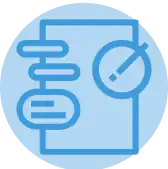
The top sections on a pharmacist CV
- Education and Qualifications highlight your formal pharmacy education.
- Relevant Work Experience showcases your practical experience in pharmacy.
- Pharmacy Skills Summary emphasises your technical and soft skills.
- Licenses and Certifications demonstrate your legal competence to practise.
- Professional Memberships indicate your commitment to the pharmacy field.
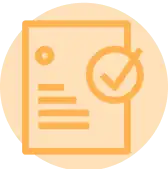
What recruiters value on your CV:
- Highlight your pharmaceutical knowledge by detailing your education and continuous professional development, including any specialist areas of practice or relevant modules that demonstrate your expertise in pharmacology.
- Emphasise your experience with medication therapy management, showcasing your ability to optimise patient outcomes through the safe and effective use of pharmaceuticals.
- Detail your proficiency in operating pharmaceutical software and managing electronic health records to demonstrate your comfort with technology and ability to adapt to new systems.
- Illustrate your soft skills, such as communication, teamwork, and customer service, to convey how you effectively interact with patients, healthcare professionals, and pharmacy staff.
- Include any experience with quality assurance and regulatory compliance to prove your understanding of the legal and ethical considerations surrounding pharmacy practice and patient care.
Recommended reads:
Our checklist for the must-have information in your pharmacist CV header
Right at the very top of your pharmacist CV is where you'd find the header section or the space for your contact details, headline, and professional photo. Wondering how to present your the name of the city you live in and the country abbreviation as your address;
- are tailored to the role you're applying for by integrating key job skills and requirements;
- showcase what your unique value is, most often in the form of your most noteworthy accomplishment;
- select your relevant qualifications, skills, or current role to pass the Applicant Tracker System (ATS) assessment. Still not sure how to write your CV headline? Our examples below showcase best practices on creating effective headlines:

Examples of good CV headlines for pharmacist:
- Lead Clinical Pharmacist | Specialist in Oncology | Patient Safety Advocate | GPhC Registered | 10+ Years Experience
- Hospital Pharmacist | Acute Care Expertise | Clinical Governance | MPharm | 5 Years Post-Registration
- Retail Pharmacy Manager | Community Health Champion | MBA in Healthcare Management | 15 Years in Pharmacy Services
- Pharmaceutical Research Scientist | Drug Development & Analysis | PhD in Pharmacology | 7 Years Industry Experience
- Senior Consultant Pharmacist | Antimicrobial Stewardship Lead | PGCert in Prescribing | NHS Excellence Award | 12 Years
- Pharmacy Operations Supervisor | Efficient Inventory Management | MSc Pharmaceutical Science | Lean Six Sigma | 8+ Years
Catching recruiters' attention with your pharmacist CV summary or objective
Located closer to the top of your CV, both the summary and objective are no more than five sentences long and serve as an introduction to your experience. What is more, you could use either to entice recruiters to read on. Select the:
- Summary, if you happen to have plenty of relevant experience. Feature your most impressive accomplishments and up to three skills that are relevant to the job you're applying for;
- Objective, if you're just starting your career off. Provide your career goals and answer how you see the role you are applying for will match your professional growth.
Judging which one you need to add to your pharmacist CV may at times seem difficult. That’s why you need to check out how professionals, with similar to your experience, have written their summary or objective, in the examples below:

CV summaries for a pharmacist job:
- Accomplished Pharmacist with over 10 years of experience in fast-paced retail environments, adept at medication dispensing, pharmaceutical calculations, and maintaining records. Recognised for streamlining operational workflows, resulting in a 15% increase in daily prescription fulfilments.
- Dedicated Pharmacy Manager with a track record of 8 years in overseeing high-volume pharmacies, specialising in creating highly efficient systems that enhanced customer satisfaction rates by 20%. Expertise in pharmacotherapy and patient counselling, coupled with a commitment to team leadership and mentoring.
- Seasoned IT Professional with 12 years of experience in software development, seeking to leverage extensive technical expertise to transition into the field of pharmacy. Keen to apply analytical skills and problem-solving abilities to promote medication safety and accuracy in dispensing.
- Experienced Educator with 15 years in secondary education, demonstrating exceptional communication and organisational skills. Pursuing a new challenge in the pharmacy sector to contribute to healthcare delivery by capitalising on profound knowledge in biology and chemistry.
- Aspiring to utilise a solid foundation in pharmaceutical principles garnered through a recently completed Master of Pharmacy degree, to launch a career in community pharmacy. Eager to develop hands-on experience, with a particular interest in improving patient health outcomes through meticulous pharmaceutical care.
- Seeking an entry-level opportunity to apply a robust educational background in pharmacology and a genuine passion for patient care, with the aim of advancing expertise in clinical pharmacy services. Determined to contribute to a patient-centric team while continuously building on pharmacological knowledge and skills.
The best formula for your pharmacist CV experience section
The CV experience section is the space where many candidates go wrong by merely listing their work history and duties. Don't do that. Instead, use the job description to better understand what matters most for the role and integrate these keywords across your CV. Thus, you should focus on:
- showcasing your accomplishments to hint that you're results-oriented;
- highlighting your skill set by integrating job keywords, technologies, and transferrable skills in your experience bullets;
- listing your roles in reverse chronological order, starting with the latest and most senior, to hint at how you have grown your career;
- featuring metrics, in the form of percentage, numbers, etc. to make your success more tangible.
When writing each experience bullet, start with a strong, actionable verb, then follow it up with a skill, accomplishment, or metric. Use these professional examples to perfect your CV experience section:

Best practices for your CV's work experience section
- Expertly dispensed and managed prescription and non-prescription medications, ensuring accurate dosages and patient safety. Maintained meticulous records compliant with legal and professional standards.
- Provided comprehensive pharmaceutical care through patient consultations, medication therapy management, and health screenings, resulting in improved patient outcomes.
- Streamlined pharmacy operations by implementing efficient stock management systems and reducing wastage, enhancing the availability of vital medications.
- Developed and maintained strong collaborative relationships with healthcare professionals, including GPs and nurses, contributing to integrated patient care.
- Stayed abreast of the latest pharmaceutical research and advancements, applying this knowledge to advise patients and healthcare providers effectively.
- Conducted regular audits of controlled substances, ensuring strict adherence to regulatory requirements and preventing misuse.
- Implemented public health initiatives within the pharmacy, such as smoking cessation programmes and flu vaccinations, increasing community health awareness.
- Customised medication regimens for patients with specific needs, including the elderly and those with chronic conditions, enhancing their quality of life.
- Delivered exceptional customer service by responding to patient inquiries with empathy and professionalism, establishing a loyal patient base.
- Directed pharmacy operations, managing a team of 4 pharmacy technicians, which led to a 50% increase in prescription filling efficiency.
- Implemented a new drug inventory system, reducing medication waste by 35% and saving the company an estimated £20,000 annually.
- Spearheaded a community outreach program to educate the public on medication safety, reaching over 5,000 individuals and enhancing the pharmacy's local reputation.
- Managed the pharmacy formulary, continuously reviewing and adding new medications, resulting in a more diverse range of healthcare options for patients.
- Conducted staff training sessions on pharmacological advancements, ensuring the team of 8 pharmacists remained current with industry standards.
- Played a pivotal role in the implementation of an electronic health record system which improved prescription accuracy by 40%.
- Orchestrated the daily workflow of prescription dispensing, effectively reducing customer wait times by 25% through strategic shift scheduling.
- Successfully managed the transition to a fully digital prescription system, which cut down on paper usage by an estimated 70% and increased workflow efficiency.
- Engaged with pharmaceutical representatives to negotiate medication pricing, resulting in an annual cost reduction of £15,000 for the most commonly dispensed drugs.
- Developed medication adherence programs which enhanced patient compliance rates from 60% to 85% over a 2-year period.
- Coordinated with healthcare providers to ensure integrated care for over 1,200 patients, substantially improving therapeutic outcomes.
- Led a vaccination campaign within the pharmacy that administered over 3,000 flu vaccines in one season, contributing to public health efforts.
- Expertly balanced retail and clinical responsibilities, providing medication counselling for an average of 80 patients per day.
- Implemented a robust medication synchronization program that coordinated patient refills and increased pharmacy efficiency.
- Drove a 20% increase in over-the-counter sales through strategic marketing and customer engagement initiatives.
- Facilitated the setup of a new pharmacy service, expanding the business and attracting a new demographic of wellness-focused customers.
- Negotiated with drug manufacturers to bring in new life-saving medications, directly impacting patient treatment options and quality of care.
- Pioneered a program for the safe disposal of unused medications that was recognized by local environmental agencies.
- Organized and led a cross-functional team to redesign the medication delivery process, achieving a 30% reduction in turnaround time.
- Served as the primary pharmacy liaison for medication therapy management services, enhancing patient engagement and chronic disease management.
- Evaluated and assimilated new pharmaceutical technologies, such as robotic dispensing systems, which improved dispensing accuracy by 99.9%.
- Oversaw the implementation of a telepharmacy program that provided remote medication consultation services to rural areas, substantially increasing access to care.
- Masterminded the reorganisation of the dispensary workflow, which resulted in a 10% increase in daily prescriptions processed.
- Acted as the key decision-maker in selecting and purchasing a state-of-the-art compounding system, enhancing the pharmacy's capability to provide personalized medications.
What to add in your pharmacist CV experience section with no professional experience
If you don't have the standard nine-to-five professional experience, yet are still keen on applying for the job, here's what you can do:
- List any internships, part-time roles, volunteer experience, or basically any work you've done that meets the job requirements and is in the same industry;
- Showcase any project you've done in your free time (even if you completed them with family and friends) that will hint at your experience and skill set;
- Replace the standard, CV experience section with a strengths or achievements one. This will help you spotlight your transferrable skills that apply to the role.
Recommended reads:

PRO TIP
Describe how each job helped you grow or learn something new, showing a continuous development path in your career.
The CV skills' divide: between hard and soft skills
Of course, you may have read the job requirements plenty of times now, but it's key to note that there is a difference between technical and personal skills. Both are equally relevant to your job application. When writing about your skill set, ensure you've copy-pasted the precise skill from the job requirement. This would not only help you ensure you have the correct spelling, but also pass any Applicant Tracker System (ATS) assessments.
- Hard skills show your technological capabilities. Or whether you'll be a good technical fit to the organisation. Ensure you've spotlighted your hard skills in various sections of your CV (e.g. skills section, projects, experience) by including the technology and what you've attained;
- Soft skills pinpoint your personality and people or communication skills, hinting at if you'll easily accomodate into the team or organisation. Quantify your soft skills in your CV achievements, strengths, summary/objective, and experience sections. Always support your soft skills with how they've helped you grow as a professional.
Top skills for your pharmacist CV:
Pharmacology Expertise
Medication Dispensing
Prescription Processing
Pharmaceutical Calculations
Drug Utilization Review
Patient Counselling
Inventory Management
Quality Control
Healthcare Laws Knowledge
Clinical Protocols
Communication Skills
Attention to Detail
Problem-Solving Abilities
Interpersonal Skills
Customer Service Oriented
Leadership
Time Management
Teamwork
Empathy
Ethical Judgment

PRO TIP
If there's a noticeable gap in your skillset for the role you're applying for, mention any steps you're taking to acquire these skills, such as online courses or self-study.
Further professional qualifications for your pharmacist CV: education and certificates
As you're nearing the end of your pharmacist CV, you may wonder what else will be relevant to the role. Recruiters are keen on understanding your academic background, as it teaches you an array of hard and soft skills. Create a dedicated education section that lists your:
- applicable higher education diplomas or ones that are at a postgraduate level;
- diploma, followed up with your higher education institution and start-graduation dates;
- extracurricular activities and honours, only if you deem that recruiters will find them impressive.
Follow a similar logic when presenting your certificates. Always select ones that will support your niche expertise and hint at what it's like to work with you. Balance both technical certification with soft skills courses to answer job requirements and company values. Wondering what the most sought out certificates are for the industry? Look no further:

PRO TIP
If you have received professional endorsements or recommendations for certain skills, especially on platforms like LinkedIn, mention these to add credibility.
Recommended reads:
Key takeaways
What matters most in your pharmacist CV-writing process is for you to create a personalised application. One that matches the role and also showcases your unique qualities and talents.
- Use the format to supplement the actual content, to stand out, and to ensure your CV experience is easy to comprehend and follows a logic;
- Invest time in building a succinct CV top one third. One that includes a header (with your contact details and headline), a summary or an objective statement (select the one that best fits your experience), and - potentially - a dedicated skills section or achievements (to fit both hard skills and soft skills requirements);
- Prioritise your most relevant (and senior) experience closer to the top of your CV. Always ensure you're following the "power verb, skill, and achievement" format for your bullets;
- Integrate both your technical and communication background across different sections of your CV to meet the job requirements;
- List your relevant education and certificates to fill in gaps in your CV history and prove to recrutiers you have relevant technical know-how.
